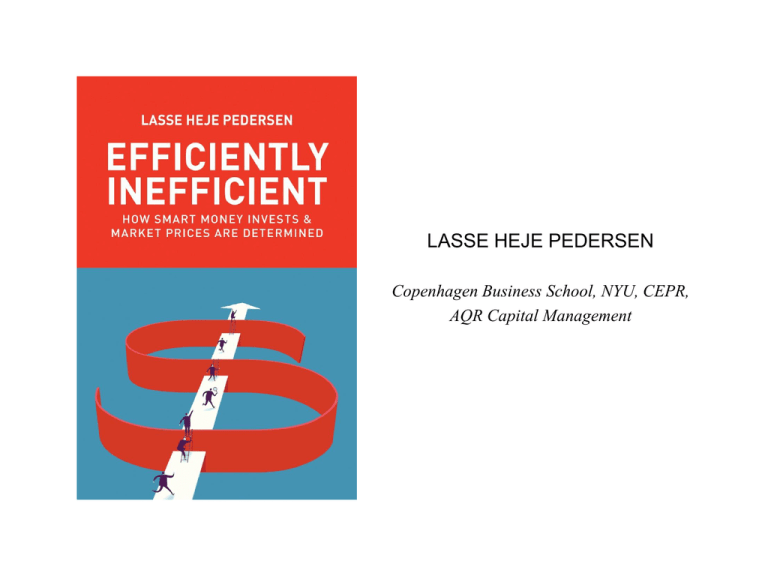Efficiently inefficient
advertisement

LASSE HEJE PEDERSEN Copenhagen Business School, NYU, CEPR, AQR Capital Management OVERVIEW OF TALK EFFICIENTLY INEFFICIENT – what does it mean? HOW SMART MONEY INVESTS & – – Demystifying the secret world of hedge funds How do you beat the efficiently inefficient market? MARKET PRICES ARE DETERMINED – Efficiently inefficient economics MARKET EFFICIENCY Market efficiency: at the heart of financial economics Nobel Prize 2013 awarded to Eugene Fama, Lars Hansen, and Robert Shiller Efficient! Inefficient! EFFICIENT MARKETS? Markets cannot be fully efficient If they were, no one would have an incentive to collect information (Grossman-Stiglitz, 1980) Logically impossible that both market for asset management and asset markets fully efficient – Asset market efficient no one should pay for active management Clear evidence against market efficiency – – – – – Failure of the Law of One Price, e.g. Siamese twin stock spreads Covered Interest-rate Parity CDS-bond basis not subject to joint hypothesis problem Completely Inefficient Perfectly Efficient EFFICIENCY-O-METER INEFFICIENT MARKETS? Markets cannot be completely inefficient Money managers compete to buy low and sell high Free entry of managers and capital If markets were completely inefficient – – Making money should be very easy But, professional managers hardly beat the market on average Completely Inefficient Perfectly Efficient EFFICIENCY-O-METER 5 EFFICIENTLY INEFFICIENT MARKETS Markets are efficiently inefficient Markets must be – – inefficient enough that active investors are compensated for their costs efficient enough to discourage additional active investing Investment implications – Some people must be able to beat the market – – at least before transaction costs and fees but even after costs, though, of course, less so Market Efficiency Efficient market hypothesis Investment Implications Passive investing Inefficient market Active investing Efficiently inefficient markets Active investing by those with comparative advantage Efficiently Inefficient Completely Inefficient Perfectly Efficient EFFICIENCY-O-METER 6 IS THE WORLD EFFICIENTLY INEFFICIENT ? Competition + frictions = efficiently inefficient dynamics Efficiently inefficient traffic dynamics Efficiently inefficient political process Efficiently inefficient nature: evolution has not converged yet BEATING THE MARKET WHEN ITS EFFICIENTLY INEFFICIENT Beating the market is very hard, but possible You need to master certain fundamental techniques You must incur significant costs/risks Asset management arises naturally due to returns to scale HOW SMART MONEY INVESTS IN EFFICIENTLY INEFFICIENT MARKETS HOW DO YOU BEAT THE MARKET? LIQUIDITY PROVISION How do you make money in any business? – E.g., consider a burger bar: – – Customers are willing to pay more for a burger than the value of meat+bun+salad Burger bars make profits for proving a service, but free entry ensures that profits are efficiently inefficient How do you make money investing? – – – Institutional frictions make certain investors “demand liquidity” Active money managers provide liquidity by taking the other side Free entry drives the price of liquidity to its efficiently inefficient level – Reflects risk, operational costs, transaction costs, funding costs Liquidity HOW DO YOU BEAT THE MARKET? LIQUIDITY PROVISION stat.arb. provides liquidity vis-à-vis supply/demand imbalances providing fixed income liquidity due to institutional frictions buying illiquid convertible bonds providing liquidity to sellers of merger target HOW DO YOU BEAT THE MARKET? INVESTMENT STYLES 1000s of hedge funds and active mutual funds – across different markets, continents, asset classes, … But, can we summarize the main trading strategies through a few investment styles? – – – method that can be applied across markets based on economics broad long-term evidence Investment styles Liquidity provision Value investing Trendfollowing Carry trading Buffett’s performance Low-risk investing Quality investing INVESTMENT STYLES: VALUE AND MOMENTUM EVERYWHERE Asness: we’re looking for cheap stocks that are getting better, the academic ideas of value and momentum Ainsley: sustainable free cash flows in comparison to enterprise value… it’s certainly important to be attuned to short-term expectations as well Chanos: we to try short overvalued firms… if a position is going against us, we’ll trim it back Soros: I look for boom-bust cycles Harding: trends are what you’re looking for Scholes: most of the fixed income business is a negative-feedback-type business unless you're directional, which is positive feedback, or trend following Griffin: view markets through the lens of relative value trading Paulson: the target stock runs up close to the offer price but trades at a discount to the offer price because of the risks of deal completion Source: Value and Momentum Everywhere, Asness, Moskowitz, and Pedersen (2013, Journal of Finance) HOW MARKET PRICES ARE DETERMINED Neoclassical models of full efficiency: – Irrational traders either cancel each other out or have no effect on prices due to arbitrageurs Behavioral finance – – Irrational traders make common mistakes and arbitrage is limited Prices bounce around the neoclassical value Efficiently inefficient markets – Liquidity risk and other institutional frictions directly affect the price Efficiently Inefficient Equity Markets Efficiently Inefficient Macro Efficiently Inefficient Arbitrage Spreads CONCLUSION: EFFICIENTLY INEFFICIENT ECONOMICS Neoclassical Finance and Economics Efficiently Inefficient Markets Modigliani-Miller Capital structure matters Two Fund Separation Investors choose different portfolios Capital Asset Pricing Model Liquidity risk and funding constraints Law of One Price and Black-Scholes Arbitrage opportunities Merton’s Rule Optimal early exercise and conversion Real Business Cycles, Ricardian Equivalence Credit cycles and liquidity spirals Taylor Rule Two monetary tools







